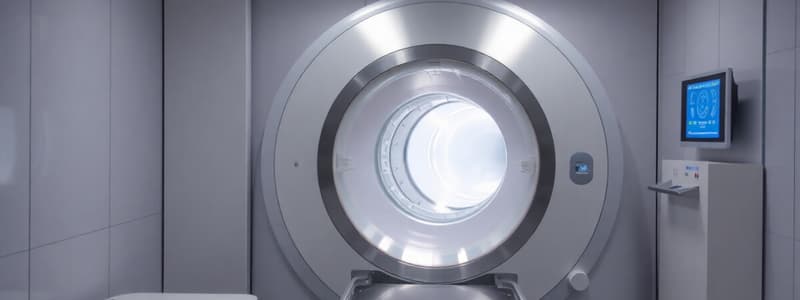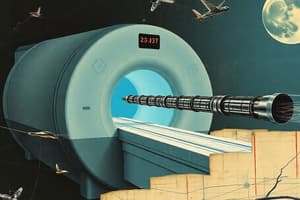Podcast
Questions and Answers
What is the primary role of the dual-stage cryocooler in an MRI system?
What is the primary role of the dual-stage cryocooler in an MRI system?
- To provide a backup cooling system
- To cool the thermal shield and re-liquefy escaping helium gas (correct)
- To maintain a constant temperature in the magnets
- To improve the efficiency of the MRI imaging process
How does laser cooling achieve a reduction in temperature of atoms?
How does laser cooling achieve a reduction in temperature of atoms?
- Through collisions with other cold atoms in the environment
- By using high-frequency light to excite the atoms
- By absorbing photons that are red-shifted to the moving atom (correct)
- By reducing the kinetic energy of atoms with blue-shifted photons
What is the significance of the Doppler effect in the context of laser cooling?
What is the significance of the Doppler effect in the context of laser cooling?
- It affects the absorption of photons by moving atoms (correct)
- It enhances the energy of the laser beams
- It increases the overall temperature of the system
- It determines the color of the laser light used
What is primarily achieved by the cooling of the magnets in an MRI system using LCS?
What is primarily achieved by the cooling of the magnets in an MRI system using LCS?
What technology is used to predict and manage cooling in a superconducting magnet?
What technology is used to predict and manage cooling in a superconducting magnet?
What happens when a stationary atom interacts with a laser that is neither red-shifted nor blue-shifted?
What happens when a stationary atom interacts with a laser that is neither red-shifted nor blue-shifted?
Why is it important to minimize helium loss in an MRI system?
Why is it important to minimize helium loss in an MRI system?
What is a key advantage of using recent technologies like LCS for magnet cooling in MRI systems?
What is a key advantage of using recent technologies like LCS for magnet cooling in MRI systems?
What is the primary purpose of using liquid helium in MRI machines?
What is the primary purpose of using liquid helium in MRI machines?
How much liquid helium is typically used in an MRI scanner?
How much liquid helium is typically used in an MRI scanner?
At what temperature is liquid helium maintained to keep the magnet superconducting?
At what temperature is liquid helium maintained to keep the magnet superconducting?
What is a major characteristic of the cryostat used in MRI machines?
What is a major characteristic of the cryostat used in MRI machines?
What innovation has been proposed for handling evaporated helium in MRI machines?
What innovation has been proposed for handling evaporated helium in MRI machines?
What does the cooling mechanism involve besides liquid helium for energy saving?
What does the cooling mechanism involve besides liquid helium for energy saving?
What is the function of the cryocooler in an MRI machine?
What is the function of the cryocooler in an MRI machine?
What must be addressed by any advanced cryogenic concept for MRI applications?
What must be addressed by any advanced cryogenic concept for MRI applications?
Flashcards
MRI Machine
MRI Machine
A medical imaging device that uses strong magnetic fields and radio waves to create detailed images of organs and tissues.
Superconducting Magnet
Superconducting Magnet
A magnet that has very low resistance to electrical current, allowing it to generate a strong magnetic field.
Liquid Helium
Liquid Helium
A super-cooled liquid used to keep the superconducting magnet in an MRI machine at extremely low temperatures.
Cryostat
Cryostat
Signup and view all the flashcards
Thermal Shield
Thermal Shield
Signup and view all the flashcards
Pre-cooling
Pre-cooling
Signup and view all the flashcards
Ramp Up
Ramp Up
Signup and view all the flashcards
Boil-off Helium
Boil-off Helium
Signup and view all the flashcards
Cryogenic Margin
Cryogenic Margin
Signup and view all the flashcards
Ramp Down
Ramp Down
Signup and view all the flashcards
Zero Boil-off
Zero Boil-off
Signup and view all the flashcards
Dual-Stage Cryocooler
Dual-Stage Cryocooler
Signup and view all the flashcards
Laser Cooling
Laser Cooling
Signup and view all the flashcards
Doppler Effect
Doppler Effect
Signup and view all the flashcards
Red-shifted light
Red-shifted light
Signup and view all the flashcards
Blue-shifted light
Blue-shifted light
Signup and view all the flashcards
Study Notes
Magnetic Resonance Imaging (MRI)
- MRI machines use super-conducting magnets and coils of wire to create a strong magnetic field.
- Superconductivity involves reducing the resistance in the wires to nearly zero.
- The wires are continuously bathed in liquid helium at -269.1°C.
- A typical MRI scanner uses 1,700 liters of liquid helium, needing periodic refills.
- Recent designs use small refrigerators for helium recondensation, creating a closed system.
Cooling of Magnets
- MRI magnets require a continuous supply of liquid helium for superconductivity.
- The cryostat (the machine holding the magnet) has an outer vacuum case with a thermal shield.
- Typical cryocooler setup is shown, with a vertical orientation to fit the cryocooler sleeve.
- The liquid helium fill level is kept between 1500-2000 liters.
- Temperature gradients and coil design influence the optimal fill volume.
- Any advanced cryogenic approach needs to optimize energy saving through pre-cooling using liquid nitrogen or a reusable helium facility.
Laser Cooling System (LCS)
- LCS is a modern technique to cool MRI magnets.
- The temperature of a laser system impacts its lifetime, performance, and safety.
- Atomic and molecular samples are cooled near absolute zero through laser interaction.
- The Doppler effect is fundamental. Doppler shift = change in wavelength/frequency due to relative movement between source and observer.
- By tuning the light frequency below the electronic transition in the atom, the atom absorbs more photons when moving towards the light source.
- As the atom moves and the laser shifts, the atom absorbs more light.
- This reduces atom speed and subsequently the kinetic energy, achieving cooling.
MRI Machine Shape
- MRI machines can be closed or open.
- Closed MRI machines have higher fields (1.5T or 3T), superior image quality, faster imaging, advanced applications, but higher patient anxiety for claustrophobic individuals and higher acoustic noise levels.
- Open MRI machines operate with lower fields (0.2T to 0.4T), lower image quality, slower imaging, fewer application options, less patient anxiety, and lower acoustic noise levels.
Comparison Between MRI Machines
- Closed MRI
- High field strength (1.5T - 3T)
- High-quality images
- Fast imaging
- Advanced applications
- Increased patient anxiety, especially for claustrophobic patients
- High acoustic noise levels
- Open MRI
- Lower field strength (0.2T - 0.4T)
- Lower image quality
- Slower imaging
- Limited applications
- Lower patient anxiety
- Lower acoustic noise levels
LCS Operation
- Four temperature sensors are placed on the four sides of the superconducting magnet to predict the temperature level.
- The control system transmits data to a controller.
- The controller uses the predicted model to provide a corresponding laser wavelength for optimal cooling.
Studying That Suits You
Use AI to generate personalized quizzes and flashcards to suit your learning preferences.
Related Documents
Description
Explore the fascinating world of Magnetic Resonance Imaging (MRI) technology. This quiz covers the principles of superconductivity, the role of liquid helium in MRI machines, and advanced cooling techniques for MRI magnets. Test your knowledge on the workings of MRI machines and their components.




